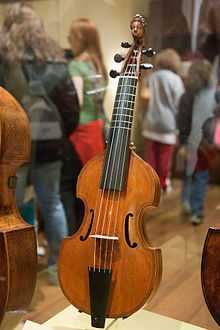Pardessus de viole

The pardessus de viole is the highest-pitched member of the viol family of instruments. It is a bowed string instrument with either five or six strings and a fretted neck. The pardessus first appeared in the early 18th century, and was commonly played by women, particularly in French-speaking countries.
Description
The pardessus de viole is the smallest of the viol family. Its size is similar to the violin's, and its range is correspondingly similar.[1] The strings are made of gut and typically range as high as g''.[2] Unlike other members of the viol family, the pardessus was almost never used to play accompaniment chords, but was always a melody instrument.[2] When played, it is played upright on the lap with a bow.[2]
History
The pardessus de viole was invented around the year 1700. Violins had begun emerging in Italy, and the pardessus was developed to allow people accustomed to viols to play violin music.[1] With a sound more reminiscent of the viol to audiences unaccustomed to the sound of the violin, musicologist Annette Otterstedt has characterized the pardessus as a hybrid between viols and violins.[1]
The pardessus was played almost exclusively by women, as the method of holding the pardessus in one's lap was considered more lady-like than holding a violin on the shoulder.[2] The pardessus was most popular in French-speaking countries,[3] but by 1770 it was starting to disappear from the landscape as viols generally were being eclipsed by modern stringed instruments.[1]
References
- ↑ 1.0 1.1 1.2 1.3 Otterstedt, Annette (2002). The Viol: History of an Instrument. Basel: Barenreiter-Verlag. pp. 146–8. ISBN 3-7618-1152-7.
- ↑ 2.0 2.1 2.2 2.3 Green, Robert (1982). J.M. Thomson, ed. "The pardessus de viole and its literature". Early Music (Early Music America) 10 (3): 301–307. doi:10.1093/earlyj/10.3.301. ISSN 0306-1078.
- ↑ Sutcliffe, Richard (28 January 2007). "About the Pardessus de Viole". Retrieved 16 December 2012.